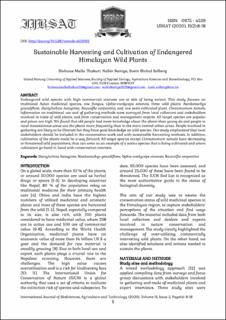Sustainable Harvesting and Cultivation of Endangered Himalayan Wild Plants
Peer reviewed, Journal article
Published version
Permanent lenke
https://hdl.handle.net/11250/2733617Utgivelsesdato
2020Metadata
Vis full innførselSamlinger
Originalversjon
International Journal of BioSciences, Agriculture and Technology (IJBSAT). 2020, 11 (2), 8-18. http://doi.org/10.5281/zenodo.4133192Sammendrag
Endangered wild species with high commercial interests are at risk of being extinct. This study focuses on traditional Asian medicinal species, one fungus, Ophio-cordyceps sinensis, three wild plants Nardostachys grandiflora, Dactylorhiza hatagirea, Rauvolfia serpentina, and one semi-cultivated plant, Cinnamomum tamala. Information on traditional use and of gathering methods were surveyed from local collectors and stakeholders involved in trade of wild plants, and from conservation and management experts. All target species are popular and prices are high. We found that old people had more knowledge about the plants than young do and people in rural mountainous areas use the plants more frequently than in the more central urban areas. People involved in gathering are likely to be illiterate but they have good knowledge on wild species. Our study emphasized that local stakeholders should be included in the conservation work and with sustainable harvesting methods. In addition, cultivation of the plants could be a way forward. All target species except Cinnamomum tamala have decreasing or threatened wild populations, thus can serve as an example of a native species that is being cultivated and where cultivation go hand in hand with conservation interests.
Beskrivelse
IJBST Journal Group is a 100% FREE NON-PROFIT Peer Reviewed Open Access Scientific Publication Group -- Journals as listed at http://www.ijbst.org.

